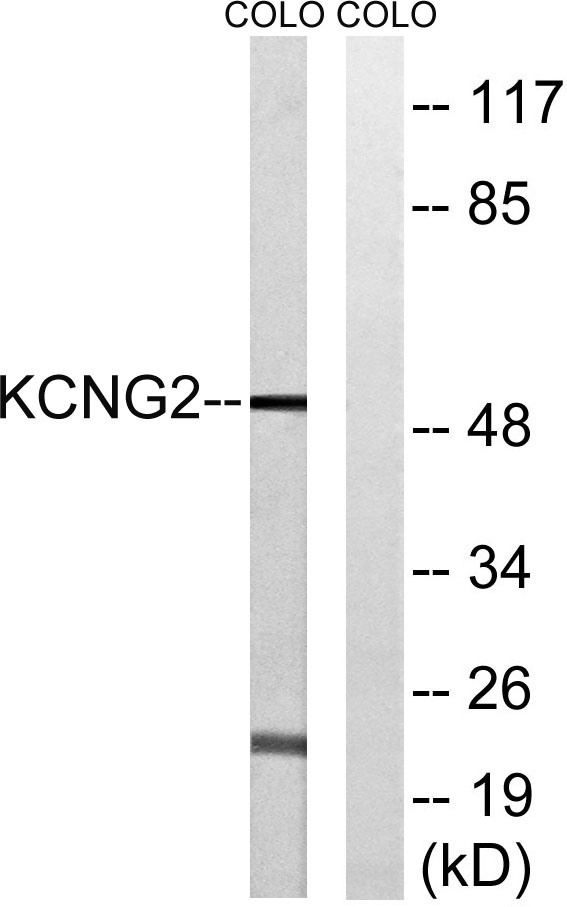KCNG2 Polyclonal Antibody
- Catalog No.:YT2454
- Applications:WB;IHC
- Reactivity:Human;Mouse;Rat
- Target:
- KCNG2
- Gene Name:
- KCNG2
- Protein Name:
- Potassium voltage-gated channel subfamily G member 2
- Human Gene Id:
- 26251
- Human Swiss Prot No:
- Q9UJ96
- Rat Gene Id:
- 307234
- Rat Swiss Prot No:
- Q9QYU3
- Immunogen:
- The antiserum was produced against synthesized peptide derived from human KCNG2. AA range:321-370
- Specificity:
- KCNG2 Polyclonal Antibody detects endogenous levels of KCNG2 protein.
- Formulation:
- Liquid in PBS containing 50% glycerol, 0.5% BSA and 0.02% sodium azide.
- Source:
- Polyclonal, Rabbit,IgG
- Dilution:
- WB 1:500-2000;IHC 1:50-300
- Purification:
- The antibody was affinity-purified from rabbit antiserum by affinity-chromatography using epitope-specific immunogen.
- Concentration:
- 1 mg/ml
- Storage Stability:
- -15°C to -25°C/1 year(Do not lower than -25°C)
- Other Name:
- KCNG2;KCNF2;Potassium voltage-gated channel subfamily G member 2;Cardiac potassium channel subunit;Voltage-gated potassium channel subunit Kv6.2
- Observed Band(KD):
- 51kD
- Background:
- Voltage-gated potassium (Kv) channels represent the most complex class of voltage-gated ion channels from both functional and structural standpoints. Their diverse functions include regulating neurotransmitter release, heart rate, insulin secretion, neuronal excitability, epithelial electrolyte transport, smooth muscle contraction, and cell volume. This gene encodes a member of the potassium channel, voltage-gated, subfamily G. This member is a gamma subunit of the voltage-gated potassium channel. The delayed-rectifier type channels containing this subunit may contribute to cardiac action potential repolarization. [provided by RefSeq, Jul 2008],
- Function:
- domain:The segment S4 is probably the voltage-sensor and is characterized by a series of positively charged amino acids at every third position.,function:Potassium channel subunit. Modulates channel activity by shifting the threshold and the half-maximal activation to more negative values.,miscellaneous:Heterodimers with KCNB1 are highly sensitive to inhibition by tetraethylammonium (TEA) and propafenone.,similarity:Belongs to the potassium channel family. G subfamily.,subunit:Heterodimer with KCNB1. Does not form homomultimers.,tissue specificity:Highly expressed in heart, liver, skeletal muscle, kidney and pancreas. Detected at low levels in brain, lung and placenta.,
- Subcellular Location:
- Membrane; Multi-pass membrane protein.
- Expression:
- Highly expressed in heart, liver, skeletal muscle, kidney and pancreas. Detected at low levels in brain, lung and placenta.
- June 19-2018
- WESTERN IMMUNOBLOTTING PROTOCOL
- June 19-2018
- IMMUNOHISTOCHEMISTRY-PARAFFIN PROTOCOL
- June 19-2018
- IMMUNOFLUORESCENCE PROTOCOL
- September 08-2020
- FLOW-CYTOMEYRT-PROTOCOL
- May 20-2022
- Cell-Based ELISA│解您多样本WB检测之困扰
- July 13-2018
- CELL-BASED-ELISA-PROTOCOL-FOR-ACETYL-PROTEIN
- July 13-2018
- CELL-BASED-ELISA-PROTOCOL-FOR-PHOSPHO-PROTEIN
- July 13-2018
- Antibody-FAQs
- Products Images

- Western Blot analysis of various cells using KCNG2 Polyclonal Antibody

- Western blot analysis of lysates from COLO cells, using KCNG2 Antibody. The lane on the right is blocked with the synthesized peptide.

- Immunohistochemical analysis of paraffin-embedded human Gastric adenocarcinoma. 1, Antibody was diluted at 1:200(4° overnight). 2, Tris-EDTA,pH9.0 was used for antigen retrieval. 3,Secondary antibody was diluted at 1:200(room temperature, 45min).



